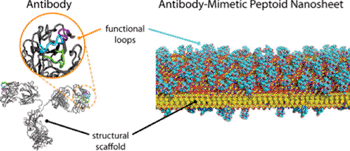Highly Stable Peptoid Nanosheets May Replace Antibodies in Biosensors
By LabMedica International staff writers
Posted on 13 Nov 2013
Ultra-thin peptoid "nanosheets" constructed from synthetic, peptide-like molecules are able to bind a wide variety of analytes with high specificity and high affinity, which makes them ideal candidates for use as molecular recognition elements for chemical and biological sensors.Posted on 13 Nov 2013
In peptoids, the side chain is connected to the nitrogen of the peptide backbone, instead of the alpha-carbon as in peptides. Notably, peptoids lack the amide hydrogen, which is responsible for many of the secondary structure elements in peptides and proteins. Like D-Peptides and beta-peptides peptoids are completely resistant to proteolysis, and are therefore advantageous for applications where proteolysis is a major issue. Since secondary structure in peptoids does not involve hydrogen bonding, it is not typically denatured by solvent, temperature, or chemical denaturants such as urea. As the amino portion of the amino acid results from the use of any amine, thousands of commercially available amines can be used to generate peptoids at costs far lower than would be required for similar peptides.

Image: Antibody-inspired “molecular Velcro” could lead to a new class of biosensors. Researchers took cues from the architecture of a natural antibody (left) in designing a new material that resembles tiny sheets of Velcro (right) (Photo courtesy of Lawrence Berkeley National Laboratory).
Investigators at the Lawrence Berkeley National Laboratory (CA, USA) described in the October 2013 issue of the journal ACS Nano the design and synthesis of a new class of functionalized peptoid nanosheets that mimicked antibody binding. The surface of these free-floating nanosheets displayed a high density of conformationally constrained peptide and peptoid loops that generated an extended, multivalent two-dimensional material that was chemically and biologically stable. The nanosheet served as a robust, high-surface area scaffold upon which to display a wide variety of functional loop sequences.
The functionalized nanosheets were characterized by atomic force microscopy, X-ray diffraction, and X-ray reflectivity measurements, and were shown to serve as substrates for enzymes (protease and casein kinase II), as well as templates for the growth of defined inorganic materials (gold metal).
"Antibodies have a really effective architectural design: a structural scaffold that pretty much stays the same, whether it is for snake venom or the common cold, and endlessly variable functional loops that bind foreign invaders," said senior author Dr. Ron Zuckermann, director of the biological nanostructures facility at the Lawrence Berkeley National Laboratory. "We have mimicked that here, with a two-dimensional nanosheet scaffold covered with little functional loops like Velcro."
"The reason that nanosheets form is because there is a code for it programmed directly into the peptoids," said Dr. Zuckermann. "In this case it is admittedly a pretty rudimentary program, but it shows how if you bring in just a little bit of sequence information: Boom! You can make a nanosheet. That is kind of, what my whole research program here is about: learning from the richness of chemical sequence information found in biology to create new types of advanced synthetic materials. We are really just starting to scratch the surface."
Related Links:
Lawrence Berkeley National Laboratory







 assay.jpg)





